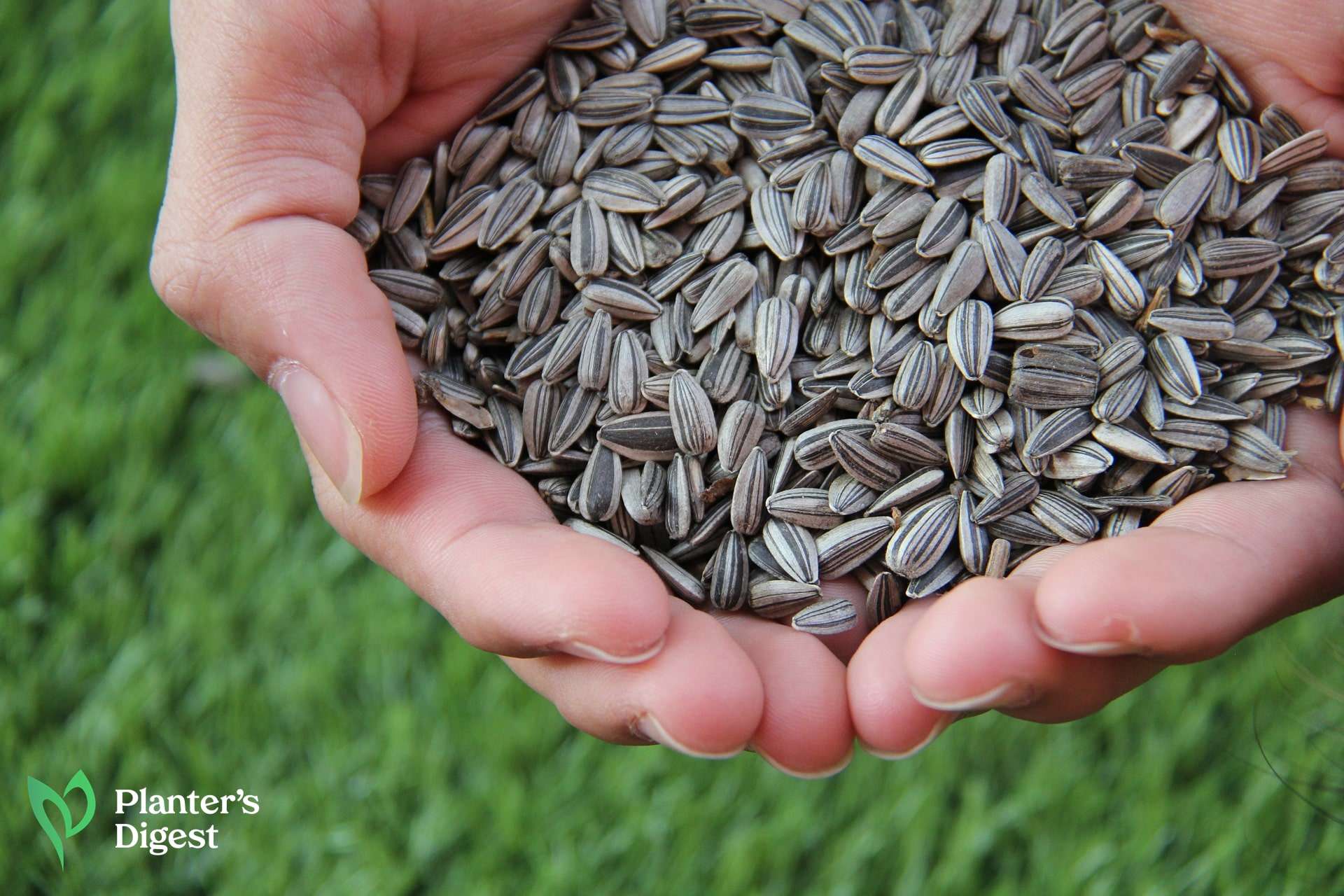
Are you planning to build a field of golden sunflowers in your outdoor space? Well, your dream field begins with a single seed.
The good news is that sunflowers are easy to grow as long as you treat their seeds correctly. Read on to kickstart your sunflower planting journey as we guide you on properly germinating your sunflower seeds.
How long do sunflower seeds take to germinate?
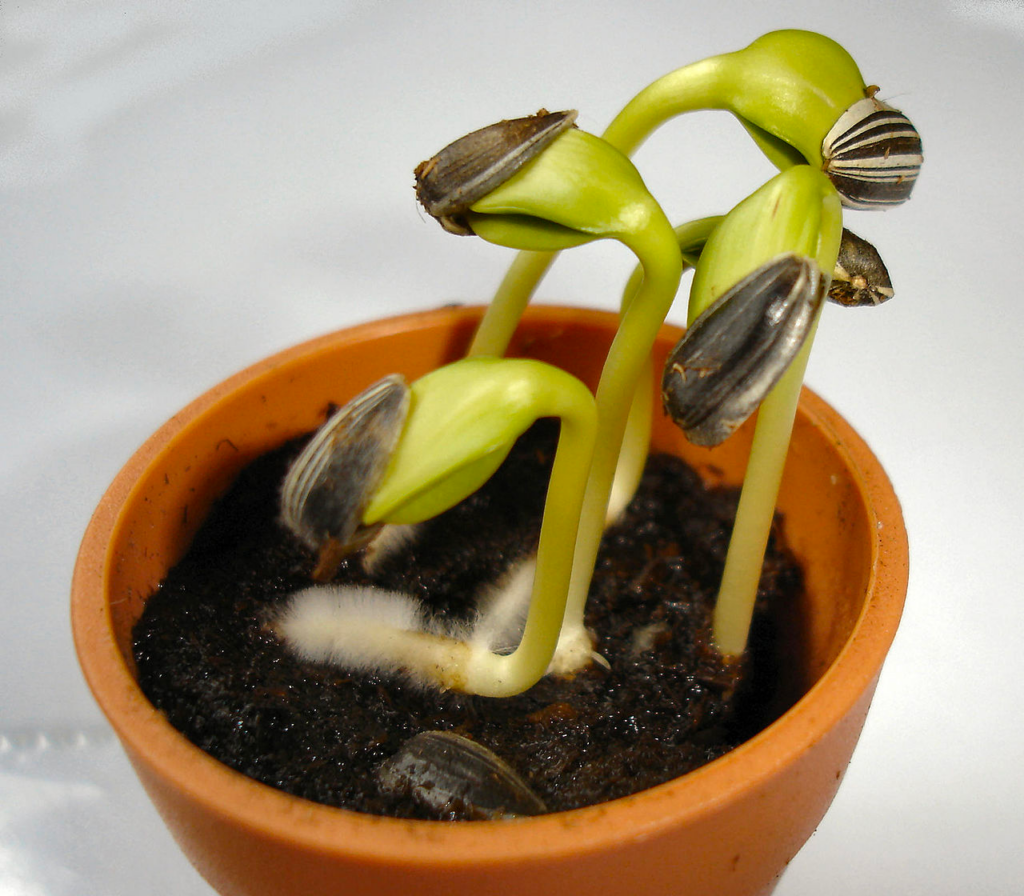
Sunflower seed germination takes 4 to 11 days, depending on the soil temperature, planting depth, air circulation, and soil moisture.
In a Thomas Jefferson Agricultural Institute study, the sunflower’s cotyledons can emerge as early as four days when it’s planted one inch deep in warm soil.
On the other hand, it will take up to 11 days when grown in cooler or deeper soils, according to research published by Purdue University.
Factors that Affect Sunflower Seed Germination
The success of the germination of sunflower seeds depend on the soil temperature, planting depth, adequate air circulation, and soil moisture.
Let’s talk about how each of these factors affects the germination of sunflower seeds.
1. Soil Temperature
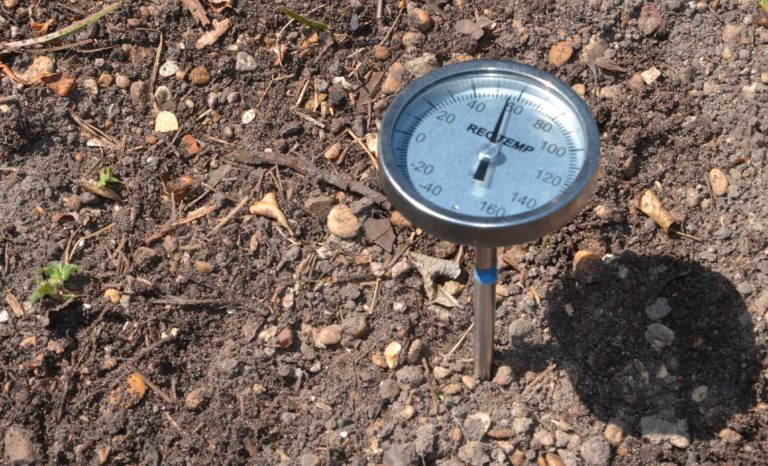
When dealing with sunflower seeds, you’ll have to hit the ideal soil temperature between 55 to 60°F (12 to 15°C). Otherwise, soil that’s too hot or cold will yield low, delayed, or no seed germination at all.
Planting the seeds below 50°F(10°C) will lead to low germination rates. Sunflowers will not naturally sprout if it’s too cold to protect themselves from the winter weather, which they will be unable to survive.
On the other hand, Purdue University found that sunflower seeds can still germinate even if the soil temperature is at 91F (32.8°C). Any higher temperature, though, will also lead to low germination rates.
To recap, here are the ideal temperatures for sunflower seed germination:
| Soil Temperature | Temperature |
| Minimum | 50°F (10°C) |
| Ideal | 55 to 60°F (12 to 15°C) |
| Maximum | 91°F (32.8°C) |
| Planter’s Tips • Use a probe-type thermometer to check the soil temperature. If the temperature is too low or cold, sow the seeds when the sun can warm up the soil. • Remove debris or lay down a cloche on the soil. These will make sure that no objects are blocking the sun. Like a glass or plastic cover, a cloche will absorb more heat and trap energy closer to the soil and the sunflower seeds. • Grow the seeds indoors. If you’re expecting cold weather, it’s best to start growing your seeds indoors. It doesn’t only protect the seeds from the extreme cold, but it also minimizes the death of the seedlings due to winter frosts. Also, when growing sunflower seeds indoors, make sure to give the seedlings grow lights or overhead lights after germination. |
2. Planting Depth
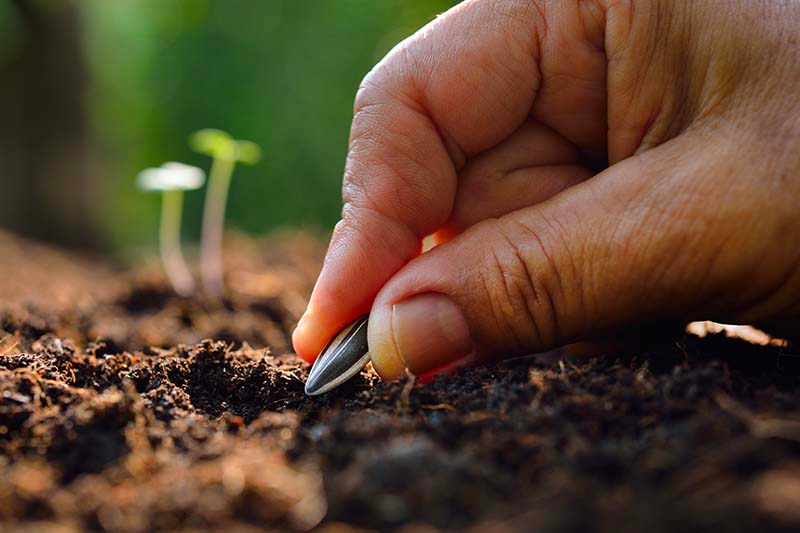
Depth is also a delicate factor to consider in seed germination. Generally, sunflower seeds should be planted between 1 to 2 inches (2.5 to 5.1 centimeters) deep for them to germinate.
Seeds planted too deep or too shallow usually have low germination rates, while others just never get the chance to reach the soil’s surface.
| Planter’s Tips • Plant the seeds at a depth twice their diameter. A rule of thumb in planting is to plant the seeds as deep as twice their diameter. So, if you have a sunflower seed that’s half-inch in diameter, you should plant it at a depth of 1 inch in the soil. • Make sure the plants or seedlings are 2 feet apart. This is especially important when the first true leaves appear because providing them enough space will prevent competition for nutrients between the plants or seedlings. |
3. Air Circulation

Even seeds need air to breathe. If the soil is too wet, coupled with low air circulation, it will mark the end of the sunflower seeds, leaving them no chance to germinate at all.
| Planter’s Tip • Keep the soil moist and loose. Don’t overwater the soil; try using a cloche to maintain the proper moisture level. You can also use a spray bottle to keep the soil damp and not too wet. Also, refrain from compacting the soil and pushing it down before or after planting the seeds. We’d like to maintain space between these soil particles so that there’s more space for air and water to circulate around the soil. |
4. Soil Moisture

We’d also like to achieve the ideal soil moisture when germinating sunflower seeds.
If the soil is too wet, then it will cause the seed to rot or develop mold. This situation is also called “damping off,” where mold, other bacteria, or fungi that cause plant diseases infect the seeds.
However, if it’s too dry, it will cause the soil to dry out and prevent seed germination altogether.
| Planter’s Tip • Use a cloche. A cloche can be made of a plastic or glass cover or even a plastic water bottle. When properly sealed, they trap moisture in the air and soil, building a humid environment ideal for seed germination. This trick is proven and tested, giving gardeners and farmers increased germination rates and less time to moisten the soil. |
How to Germinate Sunflower Seeds
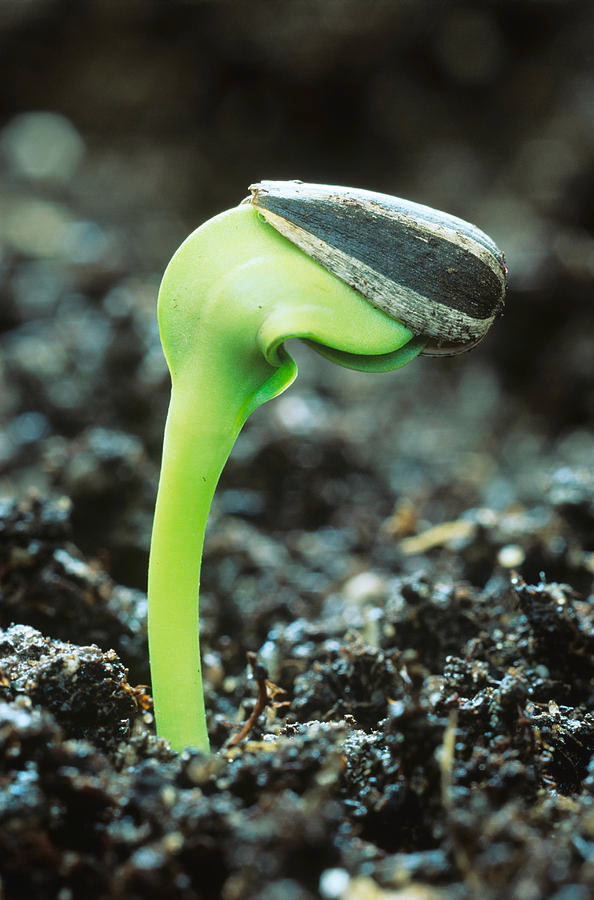
Sunflowers are known for following the direction of the sun, which is why they are rightfully called “sun worshipers.”
Because of these, sunflowers grow well in areas where they get 6 to 8 hours of full sun every day. This plant also prefers loose and well-drained soil with an acidic pH level between 6.0 to 8.5.
When planting sunflower seeds, it’s a rule to bury them 1 to 2 inches deep and about 2 to 5 inches apart. This way, the seeds will be getting enough nutrients without competing with neighbor seedlings.
Sunflower seeds germinate best when the soil temperature is between 55 to 60°F (12 to 15°C). Outdoors will most likely sprout within 11 days but in a controlled environment indoors, they can germinate as fast as 4 to 6 days.
Thereafter, it will take 4 to 11 days for the sunflower seed to germinate successfully. Following these conditions, the sunflower seed can fill 8 to 10 kg of seeds per hectare.
Here’s a wrap-up of the planting conditions conducive to sunflower seed germination.
| Plant Name | Sunflower |
| Scientific Name | Helianthus annuus L. |
| Light | Full Sun 6 to 8 hours daily |
| Soil | Loose Well-drained |
| Soil pH | Acidic 6.0 to 7.5 |
| Soil Temperature | 55 to 60°F (12 to 15°C) |
| Germination | 4 to 11 days |
| First Harvest | 70 to 105 days after planting |
| Seed Distance | 1 to 2 inch deep 2 to 6 inches apart |
| Seed Rate | 8 to 10 kg per hectare |
1. Harvest the sunflower seeds.
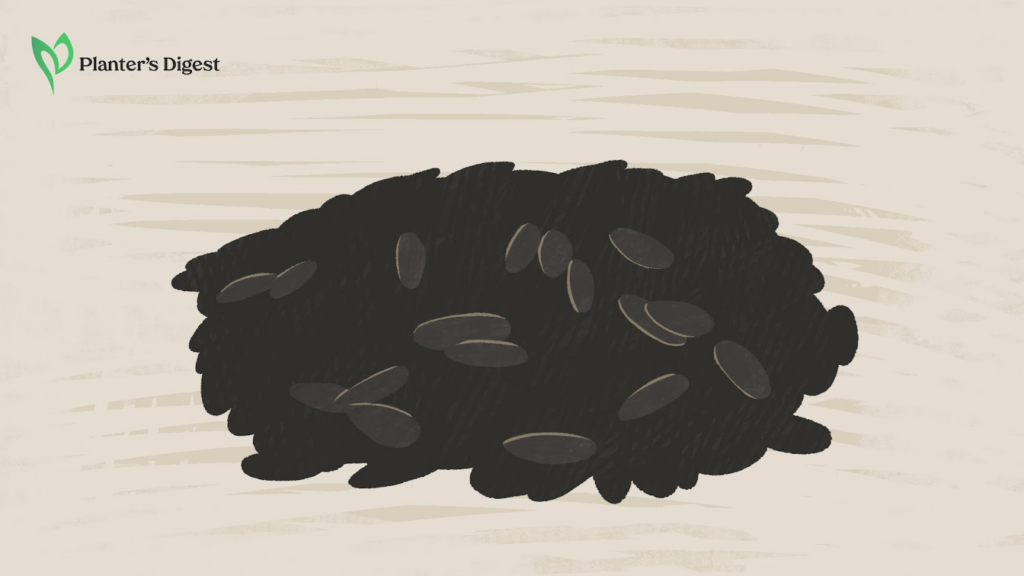
| Difficulty | Easy ●○○○○ |
| Duration | 30 minutes to 1 hour |
| Things You Need | Sunflower Knife |
We begin with getting the seeds from the sunflower heads. Sunflower seed heads are ripe when the back of the flower changes from green to yellow to brown and starts facing the east.
As many as 1,400 seeds are ready to harvest in one flower head within 110 to 125 days after planting.
A good thing about sunflowers is that they’re annual plants, so you can replant them every year. Knowing seed germination lets you keep and plant as many sunflower seeds as you want.
Here’s how to properly harvest sunflower seeds.
| How To Do 1. Cut the sunflower heads, leaving at least 12 to 18 inches of the stem attached to the main plant. 2. Hang the seed heads and let them cure for weeks before removing the seeds. 3. Spread the seeds on a flat surface and let them dry for a few days before storing them. |
2. Stretch and soak the sunflower seeds.
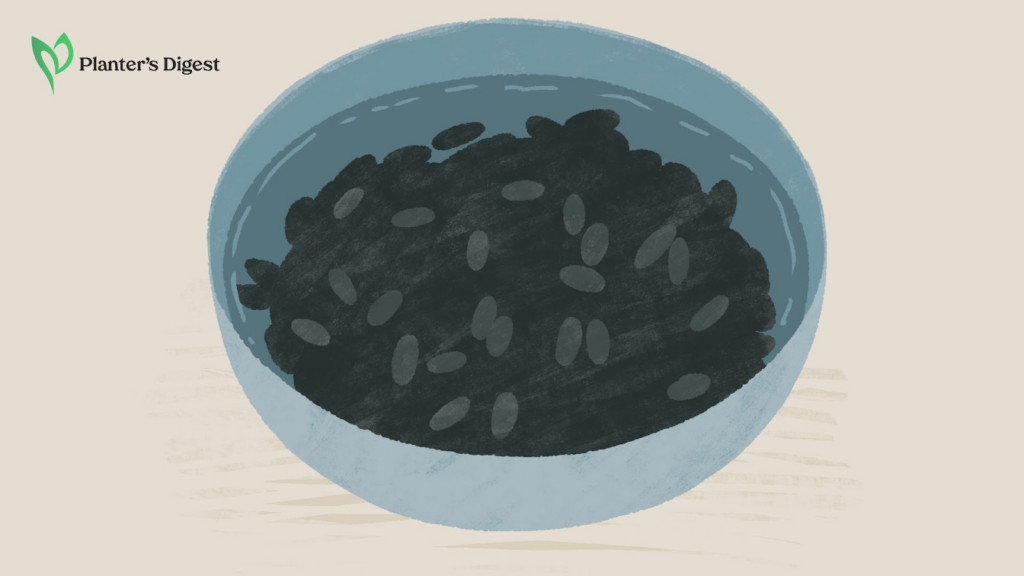
| Difficulty | Easy ●○○○○ |
| Duration | 30 minutes to 1 hour |
| Things You Need | • Sunflower seeds • Sandpaper • Water • Bowl • Sieve |
Preparation of the sunflower seed involves two phases – scarification or stretching and soaking of the seed.
Seeds like sunflowers naturally have a thick coating to prevent them from germinating in poor weather conditions. For instance, if the inner layer of the seed is exposed to water early, it might sprout during winter when it cannot survive the extreme cold.
Cue the process called “scarification,” which is the opening and weakening of the hard outer shell to speed up germination. This is the manual preparation of the seed, which is ready for planting.
During scarification, all you need is to remove a part of the hard seed skin so that water and air can enter and initiate germination.

This process should immediately be followed by soaking the sunflower seed in warm water. This breaks the seed’s dormancy period and likewise hastens germination.
After soaking the seeds, be mindful of the floating seeds because these are sterile and will not sprout. So, make sure to remove them.
Here are the steps for the scarification and soaking of sunflower seeds.
| How To Do Scarification of the Seed Skin 1. Using a small piece, rub the tip of the sunflower seed with sandpaper until the strong outer coating is removed. 2. Once you notice a lighter color, stop rubbing, as this is a sign that the outer coating has been successfully penetrated. You don’t have to remove the coating of the entire seed but only a small area. Soaking of the Sunflower Seed 1. Place warm water (40 to 50°C) in a bowl and soak the sunflower seeds for 25 minutes. 2. Remove floating seeds after 25 minutes. 3. Using a sieve, wash the seeds with clean water. 4. Leave the seeds in the open air until it dries on their own. |
3. Germinate the seeds using paper towels.
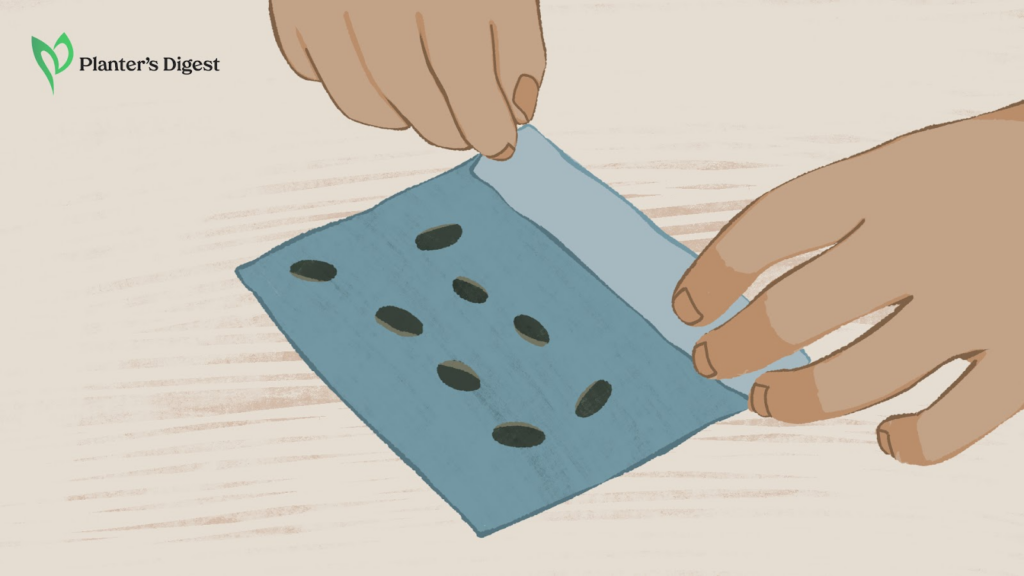
| Difficulty | Easy ●○○○○ |
| Duration | 30 minutes to 1 hour |
| Things You Need | • Sunflower seeds • Paper towel • Sprayer • Water • Plastic bag |
Germination simply means making the seeds sprout or shoot out. During this time, the plant roots start to develop, and the shoots slowly push toward the soil’s surface, looking for sunlight.
You can use different germination containers like tissue, cloth, cotton, or paper towel. The containers’ materials provide a humid environment for the seed, just enough for it to germinate and not develop mold or get rotten.
| How To Do 1. Moisten the paper towel with a water sprayer. 2. Cover the sunflower seeds on top of the moistened paper towel. 3. Put the paper towel inside a plastic bag and cover it tightly. Place the plastic bag in a dark and moist area. 4. Sunflower seeds will germinate within 4 to 11 days. If the paper towel dries, add one or two drops of water. 5. If black spots appear, remove the seeds or add a small amount of fungicide. 6. Transfer the sunflower seedlings once a cotyledon grows about 2 to 3 mm. |
4. Prepare the sunflower seedlings.
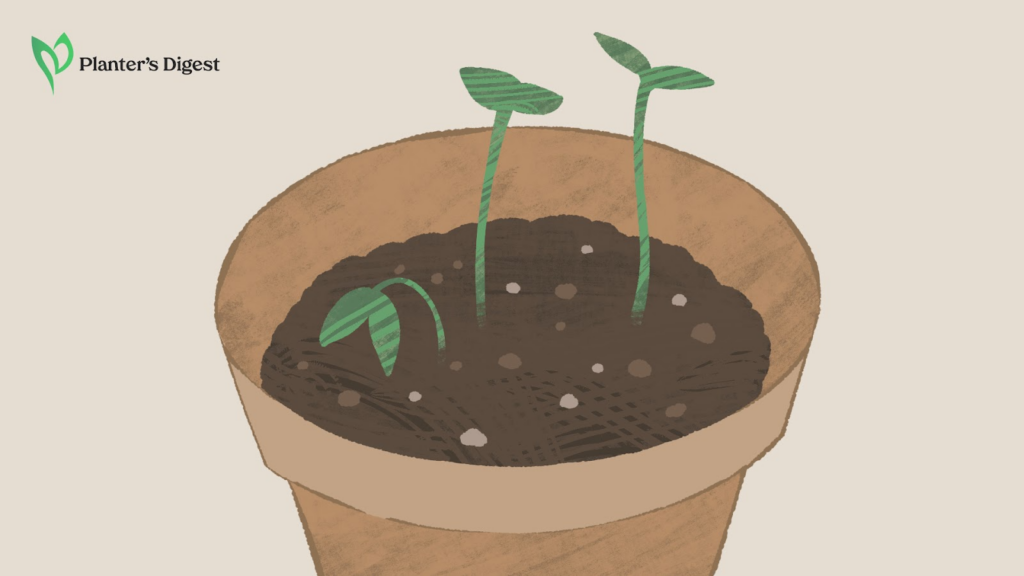
| Difficulty | Easy ●○○○○ |
| Duration | 30 minutes to 1 hour |
| Things You Need | • Seedling tray • Soil • Sunflower sprouts • Water sprayer |
Once you see two cotyledons sprouting out of the sunflower seed, it’s time to transfer them to a seedling tray.
This way, they will get more nutrients and firmly establish their roots in the soil. Here’s how.
| How To Do 1. Prepare the seedling tray by cutting enough holes for water circulation. 2. Place ¾ of soil in every seedling hole. 3. Plant the sunflower sprouts into each hole at 1 to 2 inches depth. 4. Put the seedling tray where it is exposed to direct sunlight. Spray with water 1 to 2 times a day. 5. Wait for the seedlings to grow 2 to 5 leaves before transplanting them into your garden or a pot. |
Why are my sunflower seeds not sprouting?
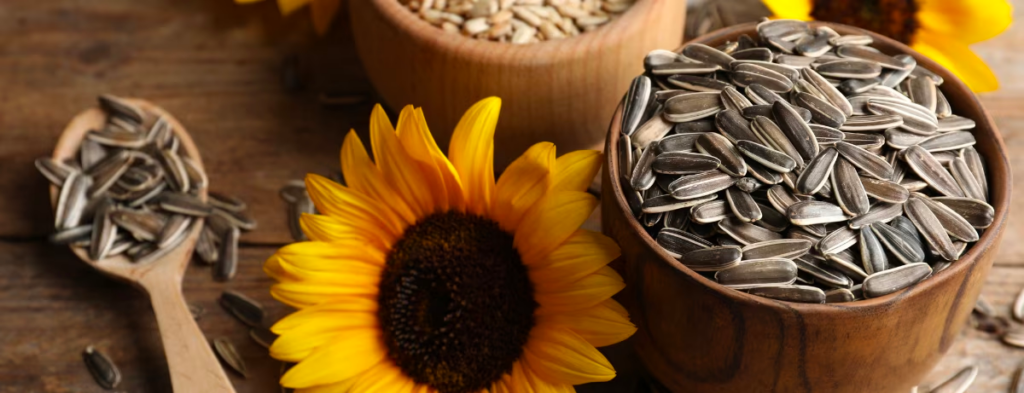
Sunflower seeds are not sprouting either because they’re too old or the soil is too dry.
Let’s understand how these conditions prevent germination.
1. Your sunflower seeds are too old.
Sunflower seeds have a lifespan of 2 to 3 years, but their germination rate decreases every year.
One way to check the viability of a sunflower seed is to place them in a bowl of water. If the seeds float, this means that they’re sterile with no embryo making them lighter, but if it sinks, then the seed is most likely still viable.
So, make sure to check the age of your sunflower seed for a higher guaranteed germination rate.
2. Your soil is too cold or dry.
Warm and moist soil is the ideal condition for sunflower seed germination.
If the soil gets too cold, the sunflower seeds will have a hard time sprouting. They can only do so once the soil warms up.
In fact, farmers usually plant sunflower seeds after the last frost has passed, during mid-April or late May in northern regions.
Finally, keep the soil moist because if it’s too dry, the seeds might die even before they get the chance to germinate.
FAQs on Sunflower Seed Germination
Sunflower seeds can be soaked for at least 24 hours before planting to speed up their germination process.
You can successfully germinate sunflower seeds in paper towels because their material can hold moisture and allow the seeds to breathe, making it a great alternative to soil.
Sunflower seedlings should be 4 to 5 inches in height or within three weeks from planting before being transplanted outdoors.
Sunflowers grow and reach maturity within 70 to 100 days after planting.
Dry and falling sunflower petals signal that the seeds are now ready for harvest. At this time, the base of the head turns from green to yellow and then brown.
Sunflowers cannot be grown in grass lawns because they will likely compete on nutrients with each other. Remove the grass where you want to place the sunflower seedling as a remedy.
Sunflowers can last 6 to 12 days when placed in a vase and adequately cared for.
Sunflowers usually grow between 1 to 15 feet tall. Interestingly, the world record for the tallest sunflower is 30 feet high.


